- Home
- About Us
- Industry
- Services
- Reading
- Contact Us
Smart Utilities Management Market: Current Analysis and Forecast (2021-2027)
Emphasis on Type (Meter Data Management, Energy Monitoring, Smart Distribution Management, and Others); Application (Power Industry, Water Supply, Transportation, Communication, and Others); and Region/Country

The global smart utilities management market is expected to register a CAGR of around 18% over the period of 2021-2027. The global market is uplifting on account of the rising investment in digital infrastructure and smart grids, and the increasing usage of innovative solutions such as smart meters. Moreover, the upgradation of aging utility infrastructure followed by the increased need for resource management will positively stimulate the industry landscape. Smart Utilities is an energy and water provider, among others, that deploys connected devices across the grid and collects data that helps them deliver services more efficiently and reliably. In addition, the rising investments in smart cities are further propelling the smart utilities management market. For instance, according to the White House Presidential Innovation Fellow project, local governments in the US will invest approximately $41 trillion over the next 20 years to upgrade their infrastructure and take advantage of the IoT. With these huge investments, the IoT will transform the quality of life of urban citizens.
International Business Machines Corporation, Atos SE, Honeywell International Inc., ABB Ltd., Cisco Systems Inc., Uplight Inc., Itron Inc., GE Group, Schneider Electric SE, and Vodafone Group Plc are some of the key players in the market. Several M&As along with partnerships have been undertaken by these players to facilitate customers with hi-tech and innovative products/technologies.
Insights Presented in the Report
“Amongst type, the meter data management held a prominent share in the market in 2020”
On the basis of type, the market is categorized into meter data management, energy monitoring, smart distribution management, and others. Among these, the meter data management segment accounted for a significant share of the smart utilities management market in 2020 and is expected to witness robust growth during the forecast period mainly due to the need to handle a huge amount of raw data and perform long-term data storage and management for the vast quantities of data delivered by smart metering systems.
“Amongst application, communication segment captured a prominent share in the market in 2020”
Based on application, the market is classified into power industry, water supply, transportation, communication, and others. Among these categories, the communication segment held a commendable share of the smart utilities management market in 2020 and is expected to witness substantial CAGR during the forecast period. The growth of this segment can be attributed to the growing communication industry along with the increasing use of smart utilities management in the information and communication technology industry.
“APAC to witness significant growth during the forecast period”
APAC accounted for a significant share of the global smart utilities management market and is expected to grow at a steady growth rate during the forecast period. This can be attributed to the rising number of large, medium, and small enterprises and the growing demand for smart utilities among enterprises in the region. In addition, the growing electronics industry is another factor contributing to the smart utilities management market in the region. For instance, according to the Indian Brand Equity Foundation (IBEF) electronics industry in India has grown the domestic production of electronics from US$ 29 billion in 2014-15 to US$ 67 billion in 2020-21.
Reasons to buy this report:
- The study includes market sizing and forecasting analysis validated by authenticated key industry experts.
- The report presents a quick review of overall industry performance at one glance.
- The report covers an in-depth analysis of prominent industry peers with a primary focus on key business financials, product portfolios, expansion strategies, and recent developments.
- Detailed examination of drivers, restraints, key trends, and opportunities prevailing in the industry.
- The study comprehensively covers the market across different segments.
- Deep dive regional level analysis of the industry.
Customization Options:
The global smart utilities management market can further be customized as per the requirement or any other market segment. Besides this, UMI understands that you may have your own business needs, hence feel free to connect with us to get a report that completely suits your requirements.
Table of Content
Research Methodology for the Smart Utilities Management Market Analysis (2021-2027)
Analyzing the historical market, estimation of the current market, and forecasting the future market of the global smart utilities management market were the three major steps undertaken to create and analyze the adoption of smart utilities management in major regions globally. Exhaustive secondary research was conducted to collect the historical market numbers and estimate the current market size. Secondly, to validate these insights, numerous findings and assumptions were taken into consideration. Moreover, exhaustive primary interviews were also conducted, with industry experts across the value chain of the global smart utilities management market. Post assumption and validation of market numbers through primary interviews, we employed a top-down/bottom-up approach to forecasting the complete market size. Thereafter, market breakdown and data triangulation methods were adopted to estimate and analyze the market size of segments and sub-segments of the industry pertains to. Detailed methodology is explained below:
Analysis of Historical Market Size
Step 1: In-Depth Study of Secondary Sources:
Detail secondary study was conducted to obtain the historical market size of the smart utilities management market through company internal sources such as annual reports & financial statements, performance presentations, press releases, etc., and external sources including journals, news & articles, government publications, competitor publications, sector reports, third-party database, and other credible publications.
Step 2: Market Segmentation:
After obtaining the historical market size of the smart utilities management market, we conducted a detailed secondary analysis to gather historical market insights and share for different segments & sub-segments for major regions. Major segments are included in the report as the type and application. Further country-level analyses were conducted to evaluate the overall adoption of testing models in that region.
Step 3: Factor Analysis:
After acquiring the historical market size of different segments and sub-segments, we conducted a detailed factor analysis to estimate the current market size of the smart utilities management market. Further, we conducted factor analysis using dependent and independent variables such as various types and applications of smart utilities management. A thorough analysis was conducted for demand and supply-side scenarios considering top partnerships, mergers and acquisitions, business expansion, and product launches in the smart utilities management market sector across the globe.
Current Market Size Estimate & Forecast
Current Market Sizing: Based on actionable insights from the above 3 steps, we arrived at the current market size, key players in the global smart utilities management market, and market shares of the segments. All the required percentage shares split, and market breakdowns were determined using the above-mentioned secondary approach and were verified through primary interviews.
Estimation & Forecasting: For market estimation and forecast, weights were assigned to different factors including drivers & trends, restraints, and opportunities available for the stakeholders. After analyzing these factors, relevant forecasting techniques i.e., top-down/bottom-up approach were applied to arrive at the market forecast about 2027 for different segments and sub-segments across the major markets globally. The research methodology adopted to estimate the market size encompasses:
- The industry’s market size, in terms of revenue (USD) and the adoption rate of the smart utilities management market across the major markets domestically
- All percentage shares, splits, and breakdowns of market segments and sub-segments
- Key players in the global smart utilities management market in terms of solutions offered. Also, the growth strategies adopted by these players to compete in the fast-growing market
Market Size and Share Validation
Primary Research: In-depth interviews were conducted with the Key Opinion Leaders (KOLs) including Top Level Executives (CXO/VPs, Sales Head, Marketing Head, Operational Head, and Regional Head, Country Head, etc.) across major regions. Primary research findings were then summarized, and statistical analysis was performed to prove the stated hypothesis. Inputs from primary research were consolidated with secondary findings, hence turning information into actionable insights.
Split of Primary Participants in Different Regions

Market Engineering
Data triangulation technique was employed to complete the overall market estimation and to arrive at precise statistical numbers for each segment and sub-segment of the global smart utilities management market. Data was split into several segments & sub-segments post studying various parameters and trends in the areas of the type and application in the global smart utilities management market.
The main objective of the Global Smart Utilities Management Market Study
The current & future market trends of the global smart utilities management market were pinpointed in the study. Investors can gain strategic insights to base their discretion for investments from the qualitative and quantitative analysis performed in the study. Current and future market trends were determined the overall attractiveness of the market at a regional level, providing a platform for the industrial participant to exploit the untapped market to benefit as a first-mover advantage. Other quantitative goals of the studies include:
- Analyze the current and forecast market size of the smart utilities management market in terms of Value (USD). Also, analyze the current and forecast market size of different segments and sub-segments
- Segments in the study include areas of type and application
- Define and analysis of the regulatory framework for the smart utilities management market industry
- Analyze the value chain involved with the presence of various intermediaries, along with analyzing customer and competitor behaviors of the industry
- Analyze the current and forecast market size of the smart utilities management market for the major region
- Major countries of regions studied in the report include Asia Pacific, Europe, North America, and Rest of the World
- Company profiles of the smart utilities management market and the growth strategies adopted by the market players to sustain in the fast-growing market
- Deep dive regional level analysis of the industry
Related Reports
Customers who bought this item also bought










